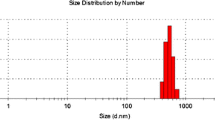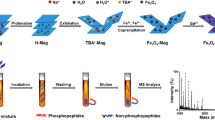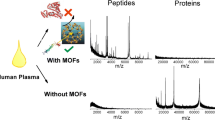Abstract
Specific enrichment and efficient detection of phosphopeptides are important for phosphoproteomic analysis. Metal–organic frameworks (MOFs) have been proved to be effective enrichment materials combined with the analysis of mass spectrometry. In this work, we have developed a polycarboxylic group MOF-UiO-66-(COOH)2 used as both efficient enrichment material for phosphopeptides and efficient desorption/ionization matrix of laser desorption/ionization time-of-flight mass spectrometry (LDI-TOF MS) without elution. The crystal is spherical and the particle size is about 200 nm. When using it as enrichment material and MS matrix, phosphopeptides of β-casein can be efficiently detected under superior low detection limits of 1 fmol μL−1, and at an extremely low molar ratio of phosphoprotein/non-phosphoprotein (1:2000) mixtures, there are still four phosphopeptides that can be observed. When detecting real samples, most phosphopeptides of non-fat milk and human saliva can be observed, which is comparable with the literature.

Graphical abstract






Similar content being viewed by others
References
Armstrong M, Sirous P, Han BS, Wang RT, Zhong CW, Liu JC, Mu B (2018) Prolonged HKUST-1 functionality under extreme hydrothermal conditions by electrospinning polystyrene fibers as a new coating method. Microporous Mesoporous Mater 270:34–39
Barbera GL, Capriotti AL, Cavaliere C, Ferraris F, Laus M, Piovessana S, Sparnacci K (2018) Development of an enrichment method for endogenous phosphopeptide characterization in human serum. A. Lagana, Anal Bioanal Chem 410:1177–1185.
Chang YJ, Yang SS, Yu XZ, Zhang H, Shang WB, Gu ZY (2018) Ultrahigh efficient laser desorption ionization of saccharides by Ti based metal-organic frameworks nanosheets. Anal Chim Acta 1032:91–98
Chatterjee A, Hu XJ, Lam FL-Y (2018) Towards a recyclable MOF catalyst for efficient production of furfural. Catal Today 314:129–136
Chen CT, Chen YC (2008) A two-matrix system for MALDI MS analysis of serine phosphorylated peptides concentrated by Fe3O4/Al2O3 magnetic nanoparticles. J Mass Spectrom 43:538–541
Chen LF, Ou JJ, Wang HW, Liu ZS, Ye ML, Zou HF (2016) Tailor-made stable Zr(IV)-based metal−organic frameworks for laser desorption/ionization mass spectrometry analysis of small molecules and simultaneous enrichment of phosphopeptides. ACS Appl Mater Interfaces 8:20929–20,300
Cheng G, Zhang JL, Liu YL, Sun DH, Ni JZ (2012) Monodisperse REPO4 (RE=Yb, Gd, Y) hollow microspheres covered with nanothorns as affinity probes for selectively capturing and labeling phosphopeptides. Chem Eur J 18:2014–2020
Gao CH, Lin G, Lei ZX, Zheng Q, Lin JS, Lin Z (2017) Facile synthesis of core–shell structured magnetic covalent organic framework composite nanospheres for selective enrichment of peptides with simultaneous exclusion of proteins. J Mater Chem B 5:7496–7503
Guo LL, Chen F, Xie N, Kou XY, Wang C, Sun YF, Liu FM, Liang XS, Gao Y, Yan X, Zhang T, Lu GY (2018) Ultra-sensitive sensing platform based on Pt-ZnO-In2O3 nanofibers for detection of acetone. Sensors Actuators B Chem 272:185–194
Han GB, Zeng QL, Jiang ZW, Xing TT, Huang CZ, Li YF (2017) MIL-101(Cr) as matrix for sensitive detection of quercetin by matrix assisted laser desorption/ionization mass spectrometry. Talanta 164:355–361
Hong YY, Zhan QL, Pu CL, Sheng QY, Zhao HL, Lan MB (2018) Highly efficient enrichment of phosphopeptides from HeLa cells using hollow magnetic macro/mesoporous TiO2 nanoparticles. Talanta 187:223–230
Hu JY, Liu C, Li QB, Shi XY (2018) Molecular simulation of thermal energy storage of mixed CO2/IRMOF-1 nanoparticle nanofluid. Int J Heat Mass Transf 125:1345–1348
Jabeen F, Hussain D, Fatima B, Musharraf SG, Huck CW, Bonn GK, Najam-ul-Haq M (2012) Silica−lanthanum oxide: pioneer composite of rare-earth metal oxide in selective phosphopeptides enrichment. Anal Chem 84:10180–10,185
Jiang JB, Sun XN, Li Y, Deng CH, Duan GL (2018) Facile synthesis of Fe3O4@PDA core-shell microspheres functionalized with various metal ions: a systematic comparison of commonly-used metal ions for IMAC enrichment. Talanta 178:600–607
Li Y, Liu YC, Tang J, Lin HQ, Yao N, Shen XZ, Deng CH, Yang PY, Zhang XM (2007) Fe3O4@Al2O3 magnetic core–shell microspheres for rapid and highly specific capture of phosphopeptides with mass spectrometry analysis. J Chromatogr A 1171:57–71
Liang YL, He XW, Chen LX, Zhang YK (2014) Facile preparation of grapheme/Fe3O4/TiO2 multifunctional composite for highly selective and sensitive enrichment of phosphopeptides. RSC Adv 4:18132–18,135
Liu QJ, Sun NR, Gao MX, Deng CH (2018) Magnetic binary metal−organic framework as a novel affinity probe for highly selective capture of endogenous phosphopeptides. ACS Sustain Chem Eng 6:4382–4389
Ma WF, Zhang Y, Li LL, Zhang YT, Yu M, Guo J, Lu HJ, Wang CC (2013) Ti4 + -immobilized magnetic composite microspheres for highly selective enrichment of phosphopeptides. Adv Funct Mater 23:107–115
Meisenbichler C, Rauch JS, Güzel Y, Wernig EM, Schemeth D, Tribus M, Tessadri R, Rainer M (2016) Development of magnetic ytterbium oxide core–shell particles for selectively trapping phosphopeptides. Anal. Methods 8:3061–3068
Peng JX, Wu RA (2018) Metal-organic frameworks in proteomics/peptidomics-a review. Anal Chim Acta 16:9–21
Peng JX, Niu H, Zhang HY, Yao YT, Zhao XY, Zhou XY, Wan LH, Kang XH, Wu RA (2018) Highly specific enrichment of multi-phosphopeptides by the diphosphorylated fructose-modified dual-metal-centered zirconium−organic framework. ACS Appl Mater Interfaces 10:32,613–32,621
Ruprecht B, Roesli C, Lemeer S, Kuster B (2016) MALDI-TOF and nESI Orbitrap MS/MS identify orthogonal parts of the phosphoproteome. Proteomics. 16:1447–1456
Saeed A, Najam-ul-Haq M, Jabeen F, Svec F (2013) High affinity phosphopeptides enrichment and desalting of biological materials on newly engineered poly(glycidyl propargyl ether/divinyl benzene). Anal Chem 85:8979–8986
Sundstrom JM, Sundstrom CJ, Sundstrom SA, Fort PE, Rauscher RLH, Gardner TW, Antonetti DA (2009) Phosphorylation site mapping of endogenous proteins: a combined MS and bioinformatics approach. J Proteome Res 8:798–807
Wang HP, Jiao FL, Guo FY, Lv YY, Wu Q, Zhao Y, Shen YH, Zhang YJ, Qian XH (2017a) Titanium (IV) ion-modified covalent organic frameworks for specific enrichment of phosphopeptides. Talanta 166:133–140
Wang SH, Niu HY, Zeng T, Zhang XL, Cao D, Cai YQ (2017b) Rapid determination of small molecule pollutants using metal-organic frameworks as adsorbent and matrix of MALDI-TOF-MS. Microporous Mesoporous Mater 239:390–395
Wang SY, Wang XY, Wang L, Pu QS, Du WB, Guo GS (2018a) Plasma-assisted alignment in the fabrication of microchannel-array- based in-tube solid-phase microextraction microchips packed with TiO2 nanoparticles for phosphopeptide analysis. Anal Chim Acta 1018:70–77
Wang XM, Guo ZY, Zhang Y, Chen ML, Wang JH (2018b) ZrO2 doped magnetic mesoporous polyimide for the efficient enrichment of phosphopeptides. Talanta 188:385–392
Wu JH, Xiao K, Zhao Y, Zhang WP, Guo L, Feng YQ (2010) Synthesis and characterization of silica-zirconia composite for the enrichment of phosphopeptides. Chin J Anal Chem 38:1231–1237
Wu H, Li XS, Zhao Y, Zhang WP, Guo L, Feng YQ (2011) Application of liquid phase deposited titania nanoparticles on silica spheres to phosphopeptide enrichment and high performance liquid chromatography packings. J Chromatogr A 1218:2944–2953
Xu SY, Whitin JC, Yu TT-S, Zhou HJ, Sun DS, Sue HJ, Zou HF, Cohen HJ, Zare RN (2008) Capture of phosphopeptides using r-zirconium phosphate nanoplatelets. Anal Chem 80:5542–5549
Yang SS, Chang YJ, Zhang H, Yu XZ, Shang WB, Chen GQ, Chen DY, Gu ZY (2018) Enrichment of phosphorylated peptides with metal−organic framework nanosheets for serum profiling of diabetes and phosphoproteomics analysis. Anal Chem 90:13796–13,805
Zhang H, Chingin K, Li JJ, Lu HY, Huang KK, Chen HW (2018) Selective enrichment of phosphopeptides and phospholipids from biological matrixes on TiO2 nanowire arrays for direct molecular characterization by internal extractive electrospray ionization mass. Anal Chem 90:12101–12,107
Zhao M, Deng CH, Zhang XM, Yang PY (2013) Facile synthesis of magnetic metal organic frameworks for the enrichment of low-abundance peptides for MALDI-TOF MS analysis. Proteomics 13:3387–3392
Zhou HJ, Low TK, Hennrich ML, Toom HVD, Schwend T, Zou H, Mohammed S, Heck AJR (2011) Enhancing the identification of phosphopeptides from putative basophilic kinase substrates using Ti (IV) based IMAC enrichment. Mol Cell Proteomics. https://doi.org/10.1074/mcp.M110.006452
Funding
The authors received financial support from National Natural Science Foundation of China (21874073).
Author information
Authors and Affiliations
Corresponding author
Ethics declarations
Conflict of interest
The authors declare that they have no conflict of interest.
Additional information
Publisher’s note
Springer Nature remains neutral with regard to jurisdictional claims in published maps and institutional affiliations.
This article is part of the topical collection Nanoparticles in Biotechnology and Medicine
Xiaoshan (Sean) Zhu, University of Nevada, Guest Editor
Highlights
• Polycarboxyl metal–organic framework UiO-66-(COOH)2 was used as matrix of laser desorption/ ionization time-of-flight mass spectrometry and adsorbent of phosphopeptides at the same time.
• Phosphopeptides were detected easily with UiO-66-(COOH)2 at a low detection limit of 1 fmol/μL.
• UiO-66-(COOH)2 showed high selectivity when detecting complex samples.
Rights and permissions
About this article
Cite this article
Yang, Y., Xia, Y. Polycarboxyl metal–organic framework UiO-66-(COOH)2 as efficient desorption/ionization matrix of laser desorption/ionization mass spectrometry for selective enrichment and detection of phosphopeptides. J Nanopart Res 21, 252 (2019). https://doi.org/10.1007/s11051-019-4646-7
Received:
Accepted:
Published:
DOI: https://doi.org/10.1007/s11051-019-4646-7




